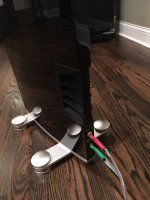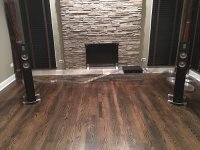Hi Jerry; I noticed a few things you said regarding your choice of speakers, the room size, etc. that made me write this note to you. First of all, never sit in the middle of room, regardless of its dimentions (unless it is a huge concert hall). The middle of the room is where you will hear the least amount of bass from your woofers as it is the point at which all bass radiation from walls, floor, ceiling, eventually meet, collide and cancel themselves out. The best place to sit in a room is 1/3 of its length in it. So for a 10ft. X 18ft room you would want to sit 5ft. from the left wall or 5 ft from the right wall, facing down the longest length of the room. Your listeing seat should be 33.3% of 18 feet which is 6 feet from the wall behind you and 12 feet from the wall in front of you. I presume you will have your speakerfs at least 28 to 48-inches out from the far wall in front of you. This will put you 8 to 10 feet away from your speakers and 10 to 12 feet away from your speakers. This is where you'll get the least number of nulls and peaks in sound in your room (the flattest dB sound response). It will also look better, like a listening room should look.
Your speakers should be at least 24-inches from the side walls (unless they are electrostatic speakers..they can be put closer to a side wall without any detriment). This would place your speakers approximately 6 feet apart in a 10-foot wide area. Since the speakers are close together, they will likely sound best pointed straight ahead. Do not tow them in if you prefer a wider spacious open sound. If you want pin-point imaging, do tow them in about 10 degrees (2 inches) which is slight but will give you a sharper image of the sound stage, but less width.
The Focal Sopra No2 (a French speaker) uses mineral (ground rock) in their mid and woofer speaker drivers to make them ridged. This lowers distortion. I find these French speakers very neutral, and cool sounding. They lack warmth and do not sound musical to me in my numerous auditions of their entire line of speakers. It is their unique kind of sound. The Wilson Sasha 2 or 3 have a similar sound (a family sound) which is rich, neutral and at times sparkly in the highs. It impresses, but after while fatigues the listener. Real music (live) does not fatigue so long as it is not played too loud. The Sonus Faber Amati Futura is a lush, warm, very musical speaker. The highs are clean and will not burn your ears out. They are smooth, well integrated and live sounding. The mid range is simply real sounding. These speakers, when not played loudly simply disappear leaving you with a live music replication and illusion. The bass is very much there when it is in the recording. Therefore, it does not have a upper bass rise to make the speakers sound as if it has powerful bass. When you play something seriously deep (50Hz or lower), this speaker will let you know you are in the basement of that tune...very powerful and felt. The upper bass, lower midrange is where this speaker sounds glorious and ultra smooth. The cabinet construction, finish and craftsmanship is also above reproach.
One last thing. Your room will likely have bass nulls and peaks because of its dimensions. You did not specify how high your ceiling is. If it is 8 ft., you will need some room treatment such as bass graps judicially placed to flatten out the base frequencies (120 to 22 Hz). If your ceiling is 10 ft. or higher, it will make the bass tolerable without room treatment or equalization. Remember, yours dimensipons, wall materials, flooring, furnishings, drapes, etc. makes up 50% of the sound you hear. If you want proof, listen to your system for a few minutes, then put on a good sounding pair of earphones and listen to the same music passage. Most of the difference you hear in tone is caused by the room. The earphones will always produce a more accurate (flat) sound than a speaker will in your room. Therefore, to get a flat sound response free from nulls (dips) and peaks in the sound you hear, digital equalization and light sound treatment of your room will let you hear what your speakers actually sound like without the room issue changing the sound put out by your speakers. A $50,000.00 pair of speakers in a bad listening room takes their accuracy and quality down to the level of what you would hear in department store from a $500.00 of speakers. I suggest you focus first on room treatment to tune your room to a flatter resonse and a good digital equalization component to tune your speakers to work with the room, thus giving you a "you are there, live illusion". Remember, stereophonic is Latin. Stereo means from two points and phonic means phony. So Stereophonic is sound from two points that is phony (not real). The art and science of audiophiledom is to produce a sound in your room that tricks you into believing you are hearing the live "you are there" sound in the venue in which the music was recorded. If you are a true audiophile, anything less then was is suggested herein is a waste of your time and money. You might as well buy a Bose table radio and settle for background music and spend your money on attending "live" musical events and get the "real thing". If, however, you crave the "real thing" in your listening room, then for heaven's sake, set up and treat your room so it can deliver to you what you want. Then put speakers in that are designed with good audio science behind them and are well built. Price is not the issue here. What your ears hear is everything. Hope this helped you. My best regards, Doc


